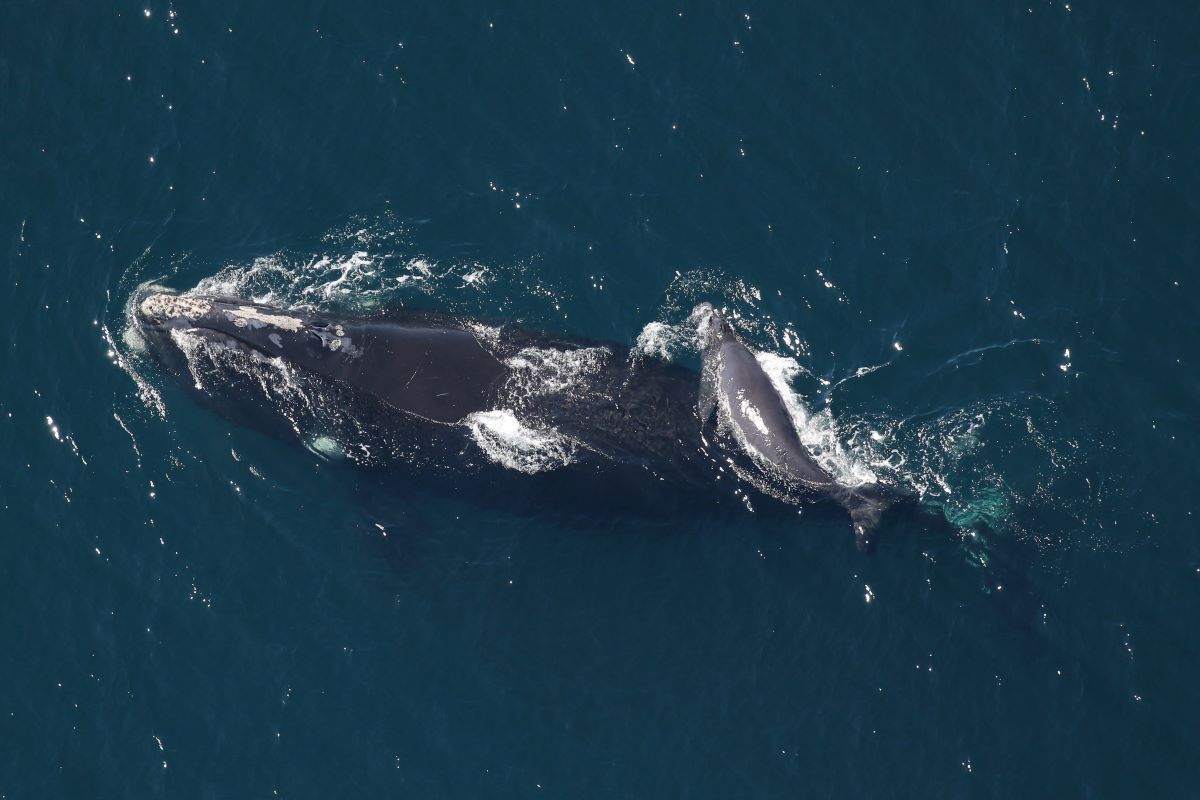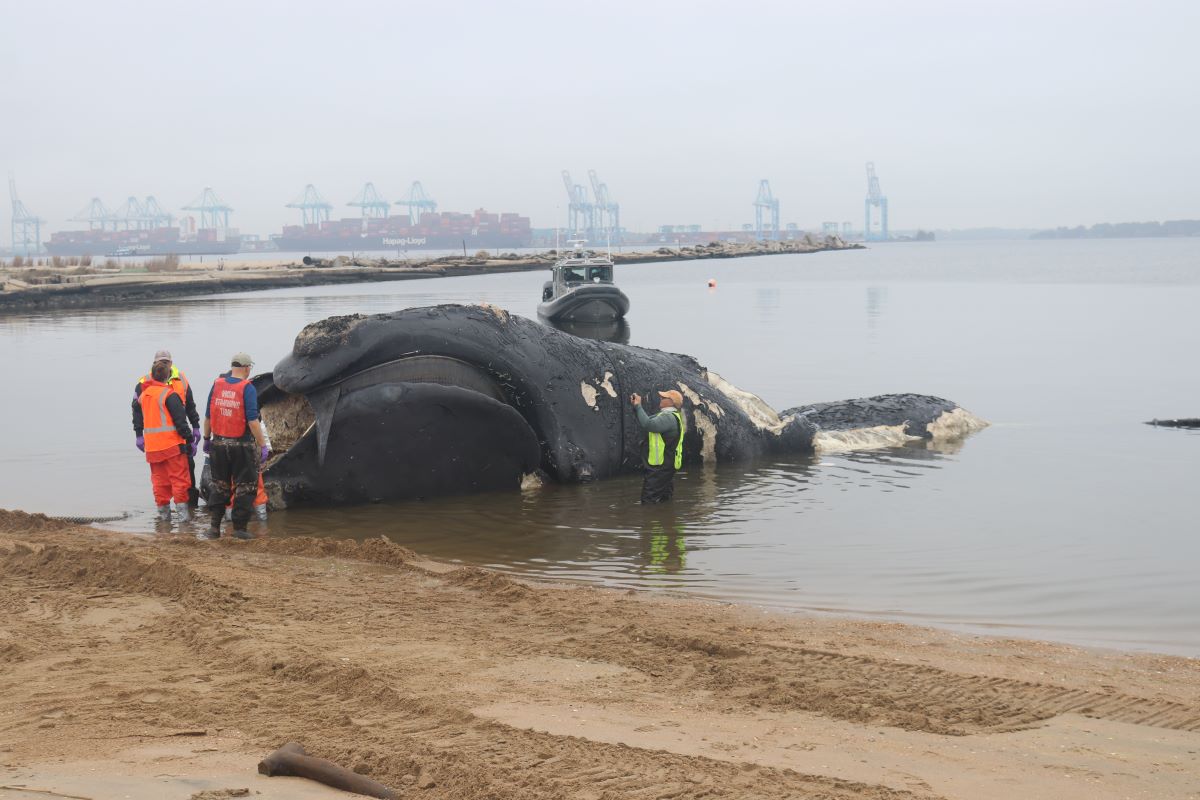
Update: The Division of Coastal Management announced late Wednesday afternoon that it had been granted an extension to review NOAA’s federal consistency submission on proposed amendments to the North Atlantic Right Whale Vessel Strike Reduction Rule. The comment period was scheduled to end at 5 p.m. Wednesday but has been extended to 5 p.m. Aug. 31.
Original post:
Supporter Spotlight
When it was veterinarian Dr. Craig Harms’ turn to speak during a public meeting Tuesday on the proposed speed rule to reduce North Atlantic right whale mortalities, he recalled being “waist-deep” while doing a post-mortem exam to determine what caused a stranded whale to die earlier this year.
He was one of the 19 who spoke during the public comment meeting the North Carolina Department of Environmental Quality’s Division of Coastal Management hosted in the Crystal Coast Civic Center.
Harms has been the director of the marine health program at N.C. State University’s Center for Marine Sciences and Technology, or CMAST, in Morehead City since 2000.
Harms explained during his allotted three minutes that he is involved in mammal stranding organizations and takes part in the post-mortem exams, or necropsies, of mammals that wash up on the beach.
Of the 41 dead right whales that have washed up since 2017, half of the mortalities were caused by vessel strikes, he said.
Supporter Spotlight
Over the last few years, the National Oceanic and Atmospheric Administration has been going through the rulemaking process to amend the existing North Atlantic right whale vessel strike reduction rule, “to further reduce the likelihood of mortalities and serious injuries to endangered right whales from vessel strikes, which are a leading cause of the species’ decline and a primary factor in an ongoing Unusual Mortality Event.”
State accepting public comments
The Division of Coastal Management staff is tasked with determining whether the proposed changes are “consistent to the maximum extent practicable with the enforceable policies of North Carolina’s Coastal Management Program,” according to its website.
As part of that, the division has been accepting public comments for the last month. The public can still submit comments. The deadline as of Friday afternoon is 5 p.m. Wednesday. However, division leadership asked NOAA for a deadline extension to allow more people to comment and were waiting for response as of deadline for this report.
Details on how to submit are on the NCDEQ website.
A division representative told Coastal Review that the state invites the public to review and comment on the proposed federal actions as part of the review process.
“These comments will be considered in developing the State’s federal consistency response to NOAA,” they said.
Division Federal Consistency Coordinator Daniel Govoni started the meeting by explaining to the roughly 30 attending that NOAA’s National Marine Fisheries Service had submitted to the state a federal consistency determination for the proposed amendments. This is a requirement for federal agencies that propose an activity that can affect a coastal resource or coastal use.
“The proposed actions include modifying the boundaries and the timing of seasonal speed restrictions of 10 knots or less to better align with areas characterized by the elevated collision or related mortality risks. It also will create a dynamic speed zone that will program to implement temporary mandatory speed restrictions when whales are known to be present,” he said. “This will be applied and also extend the size of the threshold of regulated vessels to include all vessels, or most vessels, 35 feet or greater in length. They will also update the speed fuel safety deviation provision.”
Currently, the rule states that most vessels 65 feet or longer must travel at 10 knots or less in certain areas along the East Coast during certain times of the year. For North Carolina, those areas are around Morehead City and from Wilmington to the South Carolina line, and the time of year is Nov. 1 through April 30.
With the proposed change, the rule would apply to a section of the northern Outer Banks Nov. 1 through May 30 and from Nov. 1 to April 30 for the rest of the North Carolina coast.
In addition to educators like Harms, commercial watermen, educators, conservation organization representatives, college students and researchers took the podium.
Some were in support of the speed reduction rule and some were against, but all spoke with conviction, and there was a handful of folks who appeared to misunderstand the role the division plays in the federal rulemaking process.
The speakers in support of the rule noted how critically endangered the north Atlantic right whale is as a species.
“So, what do we know about the North Atlantic right whales?” asked Penny Hooper, on behalf of the North Carolina Sierra Club, during her public comment.
They are one of the most endangered whales on the planet, with only an estimated 360 remaining whales are in the entire population. The 2008 vessel speed rule is meant to just slow vessels near the North Atlantic right whale to prevent devastating strikes that result in injuries and deaths. In 2022, NOAA proposed an update and protect these whales, she explained.
“What we have to think about is how critical it is to save this population,” Hooper said.
Many of the commercial watermen in attendance who were vehemently opposed to the rule change cited economic concerns.
Patrick Kennan of Morehead City called it “just a ridiculous rule” that will “affect more than the guy who owns the boat,” it will affect a lot of people all up and down the East Coast.
The North Carolina Marine Fisheries Commission also voiced its concerns with the rule in a letter to NOAA that it decided to send during its May meeting.
“While we fully support the protection of the critically endangered North Atlantic Right Whale, we have apprehensions about the potential impacts of these amendments on North Carolina’s fishing and boating communities,” according to the letter dated July 10. “The proposed changes could negatively affect the charter fishing industry, recreational boaters, the commercial fishing industry, and other marine operations in our state. We urge NOAA Fisheries to consider these potential impacts carefully and to continue engaging with local stakeholders to ensure that the regulations balance whale conservation with the economic and operational realities faced by our communities.”
‘Blunt-force impact’
Harms, who has spent his career studying marine mammals, told Coastal Review Thursday that his most recent experience with a right whale postmortem exam was in April. The whale was found dead offshore of the Virginia-North Carolina border and towed to shore in Virginia Beach for examination by a multi-state and multi-institution team.
“I was thinking specifically about this case when I mentioned being waist-deep in whale innards during my public comments. This whale had lower back vertebrae the size of a beer keg that had been shattered by blunt force impact, despite all of the thick blubber and muscle surrounding and cushioning them,” he said.

There are only about 360 right whales left in the world. Since the North Atlantic right whale unusual mortality event was declared in 2017, there have been 142 known cases, including 41 dead, 35 seriously injured,and 66 were slightly less than lethally injured or ill individuals.
“Of the 41 confirmed dead whales, 19 were first documented in the United States, and 22 were first documented in Canada. This does not account for offshore undetected injuries and deaths,” Harms said.
There were 24 confirmed, probable or suspected deaths as a direct result of human interaction out of the 41 whales. There were nine entanglements, 15 vessel strikes, three due to unknown causes, two perinatal deaths, one cause of death is pending, and 11 carcasses were not examined.
“It is not a simple task to retrieve a 10- to 20-ton dead animal for a postmortem examination. Nor is it a simple task to determine cause of death if they have been dead for any length of time that they decompose so much that they bloat and expel their stomachs out of their mouths. So ‘unknown’ is not due to lack of effort,” he explained.
Harms said these proposed rule changes could be a step in the right direction for right whales and other whales, including humpbacks, that suffer from ship strikes.
“But they will only help if there is compliance and enforcement, and reasonable loopholes aren’t exploited as a universal free pass. For instance, not every naval vessel transit of the Chesapeake Bay mouth is critical to national defense,” he said.
Harms said that he truly did appreciate hearing the perspective of charter boat captains and the challenges they face that are inherent in complying with speed limits.
“Although they didn’t acknowledge the seasonal or area restrictions attempting to reduce economic impacts, speed restrictions clearly will affect their livelihoods. I don’t have 100% win-win solution to offer,” Harms said.
One of the speakers at the public meeting alluded to offshore wind energy development being more responsible for the ongoing unusual mortality events of right whales, humpback whales and minke whales than vessel traffic, Harms noted.
“The wider geographic and time range of these unusual mortality events do not coincide with what is so far more limited scope of wind energy development,” Harms said. “There are justifiable concerns about potential impact of offshore wind energy development offsetting the critical need of addressing climate change impact of our current energy portfolio, but as of now, we know that vessel strikes and gear entanglements are far and away the primary causes of whale deaths along the US and Canada east coast, and we are not adequately addressing these known threats now, before worrying about potential future threats.”







